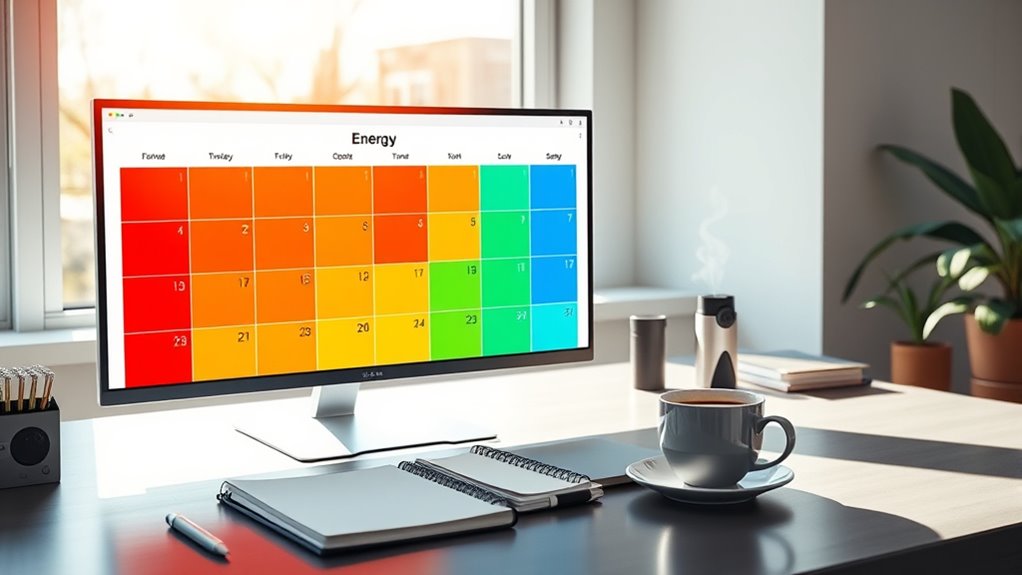Timeboxing 3.0 helps you optimize your schedule by aligning your tasks with your natural energy levels. You track how your energy fluctuates throughout the day and schedule high-focus work during your peak times. Routine tasks fit into lower-energy periods, which reduces fatigue and boosts quality. This approach supports sustainable productivity and prevents burnout. If you keep exploring, you’ll discover practical tips to fine-tune your calendar and work smarter with your energy in mind.
Key Takeaways
- Incorporate energy tracking into your calendar to schedule high-focus tasks during peak alertness periods.
- Allocate routine or less demanding activities to times when energy naturally dips.
- Use real-time energy awareness to adjust your schedule proactively, optimizing productivity and reducing burnout.
- Prioritize tasks based on energy levels, ensuring complex work aligns with high-energy windows.
- Regularly review and refine your calendar to match your evolving energy patterns for sustainable work habits.

Timeboxing 3.0 revolutionizes how you manage your time by offering a more flexible and effective approach to task prioritization. Instead of rigidly allocating blocks of time without considering your energy fluctuations, this new method encourages you to integrate your energy levels directly into your calendar. By doing so, you can optimize your productivity and ensure you’re working when you’re at your best. Recognizing that your energy ebbs and flows throughout the day, you can schedule high-energy tasks during peak periods and reserve less demanding activities for when your energy dips. This strategy doesn’t just help you get more done; it helps you do your tasks better, with greater focus and less burnout.
In practice, incorporating energy management into your timeboxing involves tracking how you feel at different times of the day. For example, if you notice you’re most alert and focused in the late morning, you can block out that window for complex, demanding tasks like strategic planning or deep work. When your energy wanes in the afternoon, you might shift to routine tasks, emails, or administrative work. This approach ensures you’re not forcing yourself to work through fatigue, which often leads to mistakes and decreased quality. Instead, it allows you to align your work with your natural energy rhythms, leading to more sustainable productivity over time.
Furthermore, timeboxing with energy levels in mind promotes a more intentional use of your time. It pushes you to become aware of your body’s signals and adjust your schedule proactively rather than reactively. This heightened awareness helps prevent burnout and maintains your motivation. As you become more attuned to your energy patterns, you’ll find it easier to set realistic goals and avoid overcommitting. You’ll also discover that productivity peaks when your work aligns with your energy highs, making your efforts more efficient and fulfilling.
Frequently Asked Questions
How Do I Determine My Energy Levels Accurately?
To determine your energy levels accurately, start with energy measurement by regularly noting how you feel throughout the day. Use fatigue tracking to identify patterns in your energy fluctuations, paying attention to times when you feel most alert or drained. Be honest and consistent in your recordings, and over time, you’ll gain valuable insights into your natural energy cycles. This helps you plan tasks when your energy is highest for better productivity.
Can Energy-Based Timeboxing Work for Team Projects?
Did you know teams that practice energy-based planning see a 25% boost in productivity? Yes, energy-based timeboxing can work for team projects. By focusing on team energy synchronization and collaborative energy planning, you can schedule tasks when everyone is most alert. This approach helps optimize collective output, reduce burnout, and boost morale, making your projects smoother and more successful. It’s a powerful way to harness your team’s energy effectively.
What Tools Support Energy-Aware Scheduling?
You can use productivity tools that support energy-aware scheduling to optimize your work. These tools often feature energy tracking, allowing you to monitor your alertness and focus levels throughout the day. Apps like Clockwise, Todoist, or Toggl Track help you adjust your tasks based on your energy patterns. By integrating energy tracking into your schedule, you stay more productive and avoid burnout, making your workflow more efficient and aligned with your natural energy cycles.
How Often Should I Reassess My Energy Levels?
Did you know that your energy levels fluctuate throughout the day, affecting your peak performance? You should reassess your energy levels at least once a day, ideally in the morning and mid-afternoon. This helps you optimize energy management, ensuring you schedule demanding tasks when your energy is highest. Regular check-ins allow you to adapt your plans, maintain productivity, and avoid burnout, keeping you aligned with your best performance.
What Are Common Challenges in Implementing Energy-Based Timeboxing?
You might face challenges like inconsistent energy tracking, making it hard to accurately schedule tasks. Habit formation can also be tough, especially if you forget to monitor your energy levels regularly. You may struggle to adapt your calendar as your energy fluctuates. To overcome these, set reminders to track energy, and focus on building the habit gradually. Consistency and awareness are key to successfully integrating energy-based timeboxing into your routine.
Conclusion
By integrating your energy levels into your calendar, you can timebox more effectively, optimize your productivity, and maintain your focus. You’ll work when you’re most energized, rest when you’re drained, and stay aligned with your natural rhythms. This approach helps you plan better, stay balanced, and achieve more with less stress. Embrace this method, adapt it to your flow, and watch how your days become more purposeful, more efficient, and more rewarding.









